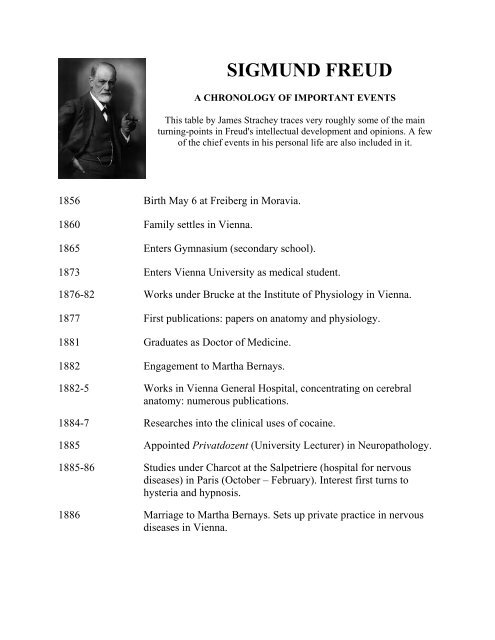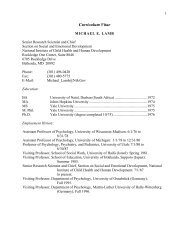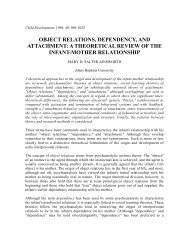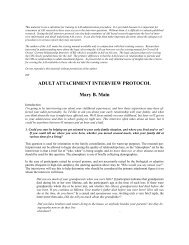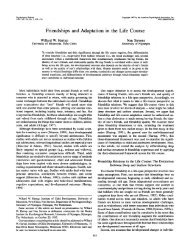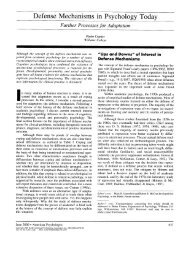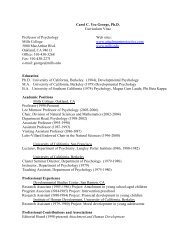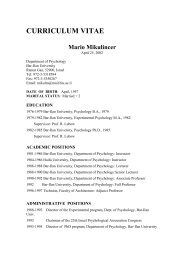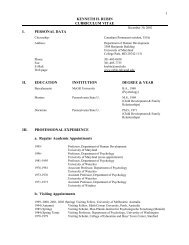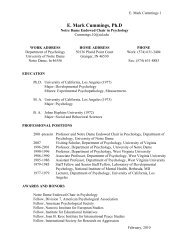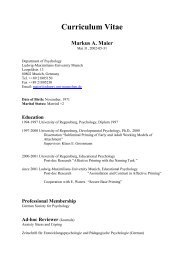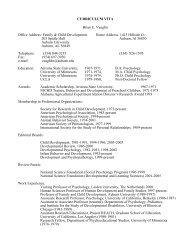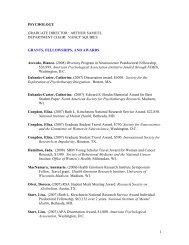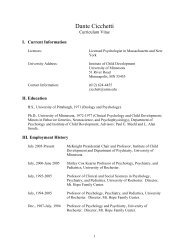SIGMUND FREUD
SIGMUND FREUD
SIGMUND FREUD
You also want an ePaper? Increase the reach of your titles
YUMPU automatically turns print PDFs into web optimized ePapers that Google loves.
<strong>SIGMUND</strong> <strong>FREUD</strong><br />
A CHRONOLOGY OF IMPORTANT EVENTS<br />
This table by James Strachey traces very roughly some of the main<br />
turning-points in Freud's intellectual development and opinions. A few<br />
of the chief events in his personal life are also included in it.<br />
1856 Birth May 6 at Freiberg in Moravia.<br />
1860 Family settles in Vienna.<br />
1865 Enters Gymnasium (secondary school).<br />
1873 Enters Vienna University as medical student.<br />
1876-82 Works under Brucke at the Institute of Physiology in Vienna.<br />
1877 First publications: papers on anatomy and physiology.<br />
1881 Graduates as Doctor of Medicine.<br />
1882 Engagement to Martha Bernays.<br />
1882-5 Works in Vienna General Hospital, concentrating on cerebral<br />
anatomy: numerous publications.<br />
1884-7 Researches into the clinical uses of cocaine.<br />
1885 Appointed Privatdozent (University Lecturer) in Neuropathology.<br />
1885-86 Studies under Charcot at the Salpetriere (hospital for nervous<br />
diseases) in Paris (October – February). Interest first turns to<br />
hysteria and hypnosis.<br />
1886 Marriage to Martha Bernays. Sets up private practice in nervous<br />
diseases in Vienna.
1886-93 Continues work on neurology, especially on the cerebral palsies of<br />
children at the Kassowitz Institute in Vienna, with numerous<br />
publications. Gradual shift of interest from neurology to<br />
psychopathology.<br />
1887 Birth of eldest child (Mathilde).<br />
1887-1902 Friendship and correspondence with Wilhelm Fliess in Berlin.<br />
Freud's letters to him during this period, published posthumously<br />
in 1950, throw much light on the development of his views.<br />
1887 Begins the use of hypnotic suggestion in his practice.<br />
1888 Begins to follow Breuer in using hypnosis for cathartic treatment<br />
of hysteria. Gradually drops hypnosis and substitutes free<br />
association.<br />
1889 Visits Bernheim at Nancy to study his suggestion technique.<br />
1889 Birth of eldest son (Martin).<br />
1891 Monograph on aphasia. Birth of second son (Oliver).<br />
1892 Birth of youngest son (Ernst).<br />
1893 Publication of Breuer and Freud 'Preliminary Communication':<br />
exposition of trauma theory of hysteria and of cathartic treatment.<br />
Birth of second daughter (Sophie).<br />
1893-8 Researches and short papers on hysteria, obsessions, and anxiety.<br />
1895 Jointly with Breuer, Studies on Hysteria: case histories and<br />
description by Freud of his technique, including first account of<br />
transference.<br />
1893-96 Gradual divergence of views between Freud and Breuer. Freud<br />
introduces concepts of defence and repression and of neurosis<br />
being a result of a conflict between the ego and the libido.<br />
1895 Project for a Scientific Psychology: included in Freud's letters to<br />
Fliess and first published in 1950. An abortive attempt to state<br />
psychology in neurological terms; but foreshadows much of<br />
Freud's later theories.
Birth of youngest child (Anna).<br />
1896 Introduces the term 'psychoanalysis'. Death of father (aged 80).<br />
1897 Freud's self-analysis, leading to the abandonment of the trauma<br />
theory and the recognition of infantile sexuality and the Oedipus<br />
complex.<br />
1900 The Interpretation of Dreams, with final chapter giving first full<br />
account of Freud's dynamic view of mental processes, of the<br />
unconscious, and of the dominance of the 'pleasure principle'.<br />
1901 The Psychopathology of Everyday Life. This, together with the<br />
book on dreams, made it plain that Freud's theories applied not<br />
only to pathological states but also to normal mental life.<br />
1902 Appointed Professor Extraordinarius.<br />
1905 Three Essays on the Theory of Sexuality: tracing for the first time<br />
the course of development of the sexual instinct in human beings<br />
from infancy to maturity.<br />
1906 Jung becomes an adherent of psycho-analysis.<br />
1908 First international meeting of psycho-analysts (at Salzburg).<br />
1909 Freud and Jung invited to the U.S.A. to lecture.<br />
Case history of the first analysis of a child (Little Hans, aged five):<br />
confirming inference previously made from adult analyses,<br />
especially as to infantile sexuality and the Oedipus and castration<br />
complexes.<br />
1910 First emergence of the theory of 'narcissism'.<br />
1911-15 Papers on the technique of psycho-analysis.<br />
1911 Secession of Adler.<br />
Application of psycho-analytic theories to a psychotic case: the<br />
autobiography of Dr. Schreber.<br />
1913-14 Totem and Taboo: application of psycho-analysis to<br />
anthropological material.
1914 Secession of Jung. 'On the History of the Psycho-Analytic<br />
Movement'. Includes a polemical section on Adler and Jung.<br />
Writes his last major case history, of the 'Wolf Man' (not published<br />
till 1918).<br />
1915 Writes a series of twelve 'metapsychological' papers on basic<br />
theoretical questions, of which only five have survived.<br />
1915-17 Introductory Lectures: giving an extensive general account of the<br />
state of Freud's views up to the time of the First World War.<br />
1919 Application of the theory of narcissism to the war neuroses.<br />
1920 Death of second daughter. Beyond the Pleasure Principle; the first<br />
explicit introduction of the concept of the 'compulsion to repeat'<br />
and of the theory of the 'death instinct'.<br />
1921 Group Psychology. Beginnings of a systematic analytic study of<br />
the ego.<br />
1923 The Ego and the Id. Largely revised account of the structure and<br />
functioning of the mind with the division into an id, an ego, and a<br />
super-ego.<br />
1923 First onset of cancer.<br />
1925 Revised views on the sexual development of women.<br />
1926 Inhibitions, Symptoms, and Anxiety. Revised views on the problem<br />
of anxiety.<br />
1927 The Future of an Illusion. A discussion of religion: the first of a<br />
number of sociological works to which Freud devoted most of his<br />
remaining years.<br />
1930 Civilization and its Discontents. This includes Freud's first<br />
extensive study of the destructive instinct (regarded as a<br />
manifestation of the 'death instinct').<br />
Freud awarded the Goethe Prize by the City of Frankfurt.<br />
Death of mother (aged 95).
1933 Hitler seizes power in Germany: Freud's books publicly burned in<br />
Berlin.<br />
1934-8 Moses and Monotheism: the last of Freud's works to appear during<br />
his lifetime.<br />
1936 Eightieth birthday. Election as Corresponding Member of Royal<br />
Society.<br />
1938 Hitler's invasion of Austria. Freud leaves Vienna for London.<br />
An Outline of Psycho-analysis. A final, unfinished, but profound,<br />
exposition of psycho-analysis.<br />
1939 Death in London, September 23


